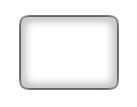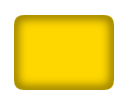Inner shadows
suggest changeCanvas does not have CSS’s inner-shadow.
- Canvas will shadow the outside of a filled shape.
- Canvas will shadow both inside and outside a stroked shape.
But it’s easy to create inner-shadows using compositing.
Strokes with an inner-shadow

To create strokes with an inner-shadow, use destination-in compositing which causes existing content to remain only where existing content is overlapped by new content. Existing content that is not overlapped by new content is erased.
- Stroke a shape with a shadow. The shadow will extend both outward and inward from the stroke. We must get rid of the outer-shadow – leaving just the desired inner-shadow.
- Set compositing to
destination-inwhich keeps the existing stroked shadow only where it is overlapped by any new drawings. - Fill the shape. This causes the stroke and inner-shadow to remain while the outer shadow is erased. Well, not exactly! Since a stroke is half-inside and half-outside the filled shape, the outside half of the stroke will be erased also. The fix is to double the
context.lineWidthso half of the double-sized stroke is still inside the filled shape.
var canvas=document.createElement("canvas");
var ctx=canvas.getContext("2d");
document.body.appendChild(canvas);
// draw an opaque shape -- here we use a rounded rectangle
defineRoundedRect(30,30,100,75,10);
// set shadowing
ctx.shadowColor='black';
ctx.shadowBlur=10;
// stroke the shadowed rounded rectangle
ctx.lineWidth=4;
ctx.stroke();
// set compositing to erase everything outside the stroke
ctx.globalCompositeOperation='destination-in';
ctx.fill();
// always clean up -- set compsiting back to default
ctx.globalCompositeOperation='source-over';
function defineRoundedRect(x,y,width,height,radius) {
ctx.beginPath();
ctx.moveTo(x + radius, y);
ctx.lineTo(x + width - radius, y);
ctx.quadraticCurveTo(x + width, y, x + width, y + radius);
ctx.lineTo(x + width, y + height - radius);
ctx.quadraticCurveTo(x + width, y + height, x + width - radius, y + height);
ctx.lineTo(x + radius, y + height);
ctx.quadraticCurveTo(x, y + height, x, y + height - radius);
ctx.lineTo(x, y + radius);
ctx.quadraticCurveTo(x, y, x + radius, y);
ctx.closePath();
}Stroked Fills with an inner-shadow

To create fills with an inner-shadow, follow steps #1-3 above but further use destination-over compositing which causes new content to be drawn under existing content.
- Set compositing to
destination-overwhich causes the fill to be drawn under the existing inner-shadow. - Turn off shadowing by setting
context.shadowColorto a transparent color. - Fill the shape with the desired color. The shape will be filled underneath the existing inner-shadow.
var canvas=document.createElement("canvas");
var ctx=canvas.getContext("2d");
document.body.appendChild(canvas);
// draw an opaque shape -- here we use a rounded rectangle
defineRoundedRect(30,30,100,75,10);
// set shadowing
ctx.shadowColor='black';
ctx.shadowBlur=10;
// stroke the shadowed rounded rectangle
ctx.lineWidth=4;
ctx.stroke();
// stop shadowing
ctx.shadowColor='rgba(0,0,0,0)';
// set compositing to erase everything outside the stroke
ctx.globalCompositeOperation='destination-in';
ctx.fill();
// set compositing to erase everything outside the stroke
ctx.globalCompositeOperation='destination-over';
ctx.fillStyle='gold';
ctx.fill();
// always clean up -- set compsiting back to default
ctx.globalCompositeOperation='source-over';
function defineRoundedRect(x,y,width,height,radius) {
ctx.beginPath();
ctx.moveTo(x + radius, y);
ctx.lineTo(x + width - radius, y);
ctx.quadraticCurveTo(x + width, y, x + width, y + radius);
ctx.lineTo(x + width, y + height - radius);
ctx.quadraticCurveTo(x + width, y + height, x + width - radius, y + height);
ctx.lineTo(x + radius, y + height);
ctx.quadraticCurveTo(x, y + height, x, y + height - radius);
ctx.lineTo(x, y + radius);
ctx.quadraticCurveTo(x, y, x + radius, y);
ctx.closePath();
}Non-stroked Fills with an inner-shadow

To draw a filled shape with an inner-shadow, but with no stroke, you can draw the stroke off-canvas and use shadowOffsetX to push the shadow back onto the canvas.
var canvas=document.createElement("canvas");
var ctx=canvas.getContext("2d");
document.body.appendChild(canvas);
// define an opaque shape -- here we use a rounded rectangle
defineRoundedRect(30-500,30,100,75,10);
// set shadowing
ctx.shadowColor='black';
ctx.shadowBlur=10;
ctx.shadowOffsetX=500;
// stroke the shadowed rounded rectangle
ctx.lineWidth=4;
ctx.stroke();
// stop shadowing
ctx.shadowColor='rgba(0,0,0,0)';
// redefine an opaque shape -- here we use a rounded rectangle
defineRoundedRect(30,30,100,75,10);
// set compositing to erase everything outside the stroke
ctx.globalCompositeOperation='destination-in';
ctx.fill();
// set compositing to erase everything outside the stroke
ctx.globalCompositeOperation='destination-over';
ctx.fillStyle='gold';
ctx.fill();
// always clean up -- set compsiting back to default
ctx.globalCompositeOperation='source-over';
function defineRoundedRect(x,y,width,height,radius) {
ctx.beginPath();
ctx.moveTo(x + radius, y);
ctx.lineTo(x + width - radius, y);
ctx.quadraticCurveTo(x + width, y, x + width, y + radius);
ctx.lineTo(x + width, y + height - radius);
ctx.quadraticCurveTo(x + width, y + height, x + width - radius, y + height);
ctx.lineTo(x + radius, y + height);
ctx.quadraticCurveTo(x, y + height, x, y + height - radius);
ctx.lineTo(x, y + radius);
ctx.quadraticCurveTo(x, y, x + radius, y);
ctx.closePath();
}
Found a mistake? Have a question or improvement idea?
Let me know.
Table Of Contents